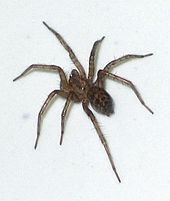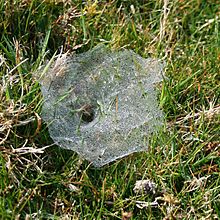- Tegenaria domestica
-
Tegenaria domestica 
Scientific classification Kingdom: Animalia Phylum: Arthropoda Class: Arachnida Order: Araneae Family: Agelenidae Genus: Tegenaria Species: T. domestica Binomial name Tegenaria domestica
(Clerck, 1757)The spider species Tegenaria domestica, commonly known as the barn funnel weaver in North America and the domestic house spider in Europe, is a member of the funnel-web family Agelenidae and a close relative of the hobo spider. Domestic house spiders range worldwide from as north as Sweden to as south as Greece in Europe and from as north as Maritime Canada to as south as Louisiana in North America. Some also inhabit parts of Western Asia.[1]
Common belief has it that T. domestica, first only occurring in Europe, was accidentally introduced to the Americas by British lumber merchants during the Napoleonic Wars era along with wooden cargo exported over the Atlantic Ocean. Recent arachnological studies, however, suggest that the species had a common ancestor with the giant house spider that spread to both Europe (through Asia) and the rest of North America from Northwestern Canada (possibly from a region currently housing British Columbia) long before the first human settlement in North America.
Contents
Appearance
Domestic house spiders possess elongated bodies with a somewhat flattened cephalothorax and straight abdomen. Their body/legs ratio is typically 50—60%, which accounts for a body size of 7.5–11.5 mm (.3–.45 in) in females and 6–9 mm (.24–.35 in) in males.[1]
Males are usually distinguished from females by having longer, more agile legs, bloated pedipalps and elongated abdomen. Other distinctions are strictly behavioral.
The coloring of an adult T. domestica is typically dark orange to brown or beige (maybe even grayish), with a common characteristic of striped legs and two dull, black, longitudinal stripes on the cephalothorax. The abdomen is mottled in brown, beige, and grey and has a pattern of chevrons running lengthwise across the top (similar to an argyle pattern).
Behaviour
Barn funnel weavers are active and agile hunters, relying on both their vision and movement speed as well as web mechanisms. Their eye configuration, with six out of eight sighting forward, allows them to distinguish even the smallest movement in front of them and either follow it, or retreat, if the movement is too considerable. These spiders are also known to be photosensitive, i.e. moving to or fleeing from the light, depending on situations.
Like many agelenids, barn funnel weavers are very precise in their movements. Instead of following a continuous gait pattern, they usually move in short intervals, stopping several times before deciding where to head next. Males will wander aimlessly around the house if undisturbed, but will soon switch to the running interval if prey or threat are spotted. Their legs are perfectly fit for walking (with tarsi bent outward on the tips) and spiders can run over quite long distances in both situations.
This spider builds a funnel-shaped web to catch its prey. It usually consists of a multitude of stressed silk threads spun over a flat surface (such as a windowsill) near any corner, with a funnel-like structure reaching for the corner, in which the spider would typically reside (hence the name). These webs can become quite large if undisturbed. They act like cord strings, helping the spider glide over them, and once a prey stumbles into the web, it will quickly get attacked, then dragged inside the funnel part and eaten, but very rarely stored underneath the structure.[2]
Females that dwell indoors would usually live for over one or two years on the same web, with some residing for as long as seven years in rarely disturbed places (attics, basement or cellar parts, storage rooms, etc.). Outdoor females perish with cold weather and males rarely live for over a year. In late Fall, an egg sac is made containing up to 50 eggs and put in the very tip of the funnel, protected by the female. The spiderlings will hatch in early to mid April and go over seven molts to reach adulthood.
Defense mechanisms
See also: Spider biteT. domestica is not an aggressive species and will retreat when threatened by larger creatures (e.g. humans). As long as its web is undisturbed, the spider will retreat to the funnel tip and stop responding to any movement whatsoever. If the web is attacked and partially destroyed, the spider will attempt to flee the area or may huddle its body into a ball against the wall or some other nearby object. To usher the spider into a cup for relocation, hold the cup in front of the spider and use something to gently nudge the spider from behind. A spider's first reflex after being touched from behind is to walk or run forward. The spider will walk right into the cup that is placed in front of it.
Domestic house spiders may or may not inject venom during a bite (a venom-less bite is called a "dry bite"). Spiders prefer to use their venom for subduing their prey and do not always use it as a defense mechanism. Their venom is both neuro- and necrotoxic and can leave small lesions over the bitten area, similar to that of a burn. Besides causing considerable local pain, venom effects are minimal in healthy adults and may sometimes include malaise and fatigue feelings in children and elderly, but will usually wear off on the same day. The bite area is better treated with iodine and will disappear within the next three days. No medical attention is required.[1][3]
Surprisingly enough, these spiders can be very docile if recently fed. They can easily be manipulated and even taken away from their webs and grabbed, without much aggressive behavior. On the contrary, females protecting their eggs can also appear to be slow moving and docile, but will not hesitate to defend their young. In any situation, it is recommended to handle the spider with care and make sure it has first been dealt with when removing its web.
References
- ^ a b c "Barn Funnel Weaver spider". Pennstate Department of Entomology. http://www.ento.psu.edu/extension/factsheets/Spider/barnFunnelWeavers.htm. Retrieved 2007-05-14.
- ^ "Bug Guide:Tegenaria domestica". http://bugguide.net/node/view/31445. Retrieved 2007-05-27.
- ^ "Dangerous spiders". Washington State University. http://cru.cahe.wsu.edu/CEPublications/eb1548/eb1548.html. Retrieved 2007-05-15.
External links
Categories:- Tegenaria
- Spiders of Europe
- Animals described in 1757
Wikimedia Foundation. 2010.



